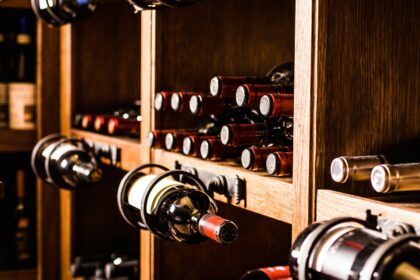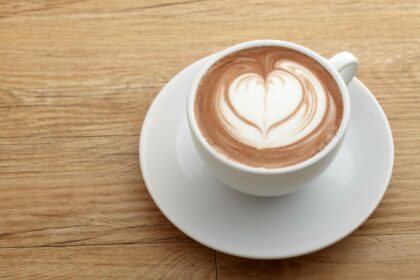
“Have you ever realized you could put a slice of ginger in a gin and tonic? Well, you can.”
I’m currently in the Herrenzimmer aboard Hapag-Lloyd’s MS EUROPA 2 luxury cruise ship partaking in a gin tasting experience. Led by Erik Schutze, the ship’s Public Room Manager, the class allows up to 25 guests to have a unique tasting experience you won’t find on many other cruises. Moreover, as the EUROPA 2 features the world’s largest gin collection at sea — 35+ popular and rare gins in total, compared to five or six on most ships — it’s the perfect place to do this.
As soon as I walk into the cozy yet sleek venue, with its chocolate-brown leather chairs, fiber optic fireplace and pale green walls adorned with modern art, I’m handed an aperitif, a “Monkey Sloe Fizz” made with Monkey 47 Sloe Gin, lemon, sugar, soda water and a dash of Angostura Bitters. It’s refreshing and invigorating, awakening the palate. Right before the bar a wooden counter showcases high-quality gins and bowls of spices and garnishes like juniper, coriander, cinnamon, nutmeg, bay leaf, curry, star anise, pepper and clove, to name a few. The bar itself is beautifully stocked with 265 different spirits, including a premium small-batch Blue Gin, enticing guests with their shiny bottles.

Gin History
After some sipping and mingling the group eventually sits down to begin the tasting. First, a bit about gin itself. According to Schutze, gin originated in the Netherlands in the 1600s when people were distilling juniper, although most gin today comes from England. As stated by The Guardian, gin has had an interesting history, with public perception surrounding the spirit changing dramatically over the years. In in the late seventeenth century gin became popular for its ability to be mixed with water and easily produced, as well as the fact it was cheaper than other spirits; however, this led to widespread alcoholism and depression in the proceeding century. Luckily, the nineteenth century brought advances in technology that allowed for higher quality gins and a more regulated industry — plus, the addition of tonic water for gin and tonic cocktails allowed for a health boost, as the mixer contained quinine that fought malaria. It’s also worth mentioning that during The Plague in the mid-1300s people used juniper elixer as a cure and preventative against illness. By the Jazz Age, gin cocktails were perceived as being glamorous, and even today there is a fascination with this mysterious spirit.

Gin Alcohol Content & Classification
That being said, it is not like Champagne or Madeira where it can only be produced in one region. Gin can be made anywhere in the world. It is based on neutral alcohol flavored with grains, botanicals and juniper, the main flavor component which is often what leads people to have a love/hate relationship with the spirit. Gin is also high alcohol, with typically 37.5% ABV or higher.
“Alcohol content affects the flavor of the gin, so that every Master Blender decides for him or herself what alcoholic strengths is best for their gin so that the gin can develop its full flavor,“ explains Schutze.
Gin can be classified into four categories. London Dry Gin, the most common type of gin, is not necessarily produced in London, but has a 37.5% ABV or higher, a maximum of 0.1 grams per liter of sugar (dry) and a maximum of 5 g/hl. Then there’s Plymouth Gin, which is made in Plymouth and has 40% of higher ABV. With Sloe and Damson Gin, there is a 25% ABV. And when people talk about Old Tom Gin they mean it is sweetened.

Gin Tasting
The tasting begins with a “50 Pounds Gin” from England’s Thames Distillers, distilled four times for a full-bodied gin with balanced essences of juniper, spices and citrus. We first sample it pure, before trying it with an ice cube and orange peel — not the common lemon wedge — garnish, as Schutze believes this will help to bring out the spirits’ fruit flavors.
“To properly taste the gin there is a four-part process,” explains Schutze. “One must first smell the gin and then taste it. This process is then repeated after adding an ice cube — the ice cube ‘breaks’ the gin. The process is then repeated a third time after adding the zest — the ingredients, lemon and lime. The final try, the end product gin and tonic, is tasted after the tonic water is added. Tonic won’t mask the flavor of the gin, and reduces the alcohol to release the flavors of the botanicals.”
Next we’re on to the “Monkey 47 – Schwarzwald Dry Gin” by Black Forest Distillers in Germany, containing 47 different botanicals — like slow, fir and honeysuckle — hand-picked from Germany’s Black Forest. Crafted from an old family recipe, the gin is aged for 100 days in an earthware container before being diluted. As they make only 1,000 bottles each year, this is a rare offering — as well as the EUROPA 2’s most popular gin used for the traditional at-sea cocktail, the gin and tonic. This gin is more fruity than the first with a black pepper finish, and is also served with an orange peel twist.

I’m beginning to realize gin and wine tasting have a lot in common. Like wine, gin can have a vintage (although, unlike wine gin does not get better with age, although the quality ingredients and tools used used may vary depending on the year). Moreover, the tasting process involves using all of your senses, first noting the gin’s color as the light hits it, as both the botanicals used and the maceration process — where tannins, color agents and flavors compounds are leached from the grapes skins, seeds and stems –affect the hue. Next, you swirl the liquid and allow it to open up, the aromas floating to the rim. Now inhale the fragrances, wafting the glass past your nose and smelling the fruit, spices, wood, citrus and earthiness. Lastly, you sip, moving the gin around your palate and seeing how it affects your taste buds and receptors.
For our final tasting, we savor a Darnley’s View Spiced London Dry Gin from Wemyss Malts in London. It’s traditionally distilled five times in a pot-still process. There are 10 botanicals included in this gin: juniper, cinnamon, nutmeg, cassia, Guinea pepper, ginger, cumin, clove, coriander and angelica root. On its own the first thing I think of is Christmas, as the sweet spices bring images of spruce trees with dangling gold balls, roasted chestnuts and cocoa in front of the fire. It would be the perfect gin to sip on a cold winter day. Once the tonic is added it’s garnished with a slice of ginger, which softens the intense cinnamon while adding another spice to the mix for complexity.

The Cocktails
After the class, my curiosity about the cocktail menu and its gin offerings is piqued. I take a look through the menu, perusing the many options. When I ask Schutze what the strategy is for coming up with a gin cocktail for the bar, he smiles, “Try out, taste. Try out, taste. Try out, taste.”
Well that doesn’t sound too hard, although after partaking in the gin tasting — not to mention going for my sommelier certification — I know the world of alcoholic drinks can be more complicated than people think.
Some cocktails of note on the menu include a “Singapore Sling” made with Gordon’s Gin, Cointreau, Cherry Heering, DOM Benedictine, grenadine, lemon juice, pineapple juice and Angostura Bitters and a “Tarragon Smash” with Gordon’s Gin, passion fruit nectar, tarragon, lim juice and sugar. You can also tell the bartender what types of drinks and flavors you like to have a cocktail custom crafted just for you.
EUROPA 2 U.S. Launch
For those who want to partake in an educational gin tasting for themselves or who just want to savor a gin-infused cocktail in the Herrenzimmer Bar, book a cruise aboard Hapag-Lloyd’s EUROPA 2, set to debut in the United States in December 2014, and already sailing from Europe since May 2013. The launch cruise will sail from New York to Miami, December 6 to 20, 2014. Ports of call will include St Barts, St. John, Antigua, Îles des Saintes (part of Guadeloupe, in the Lesser Antilles), St. Lucia, St. Vincent and the Grenadines, Curacao, and the Great Inagua/Bahamas.
For this cruise, they’re offering a 2-FOR-1 SALE of $8,610 per couple for room categories 1-4, with no surcharge for solo travelers. You can book toll free from the USA & Canada by calling 877-445-7447.
What your most memorable gin experience? Please share in the comments below.
Jessica Festa
Latest posts by Jessica Festa (see all)
- A Culturally-Immersive Adventure In Mongolia’s Altai Mountains - Jul 8, 2023
- This Recipe Sharing Platform Supports Women In The Culinary Industry (Labneh Recipe Included!) - Nov 5, 2020
- Hiking The Mohare Danda Community Eco-Trek In Nepal - Jun 3, 2020
- 6 Important Questions For Choosing A Responsible Yoga Retreat - May 18, 2020
- How To Create & Grow A Profitable Blogging Business (Ethically) - Jan 18, 2020




